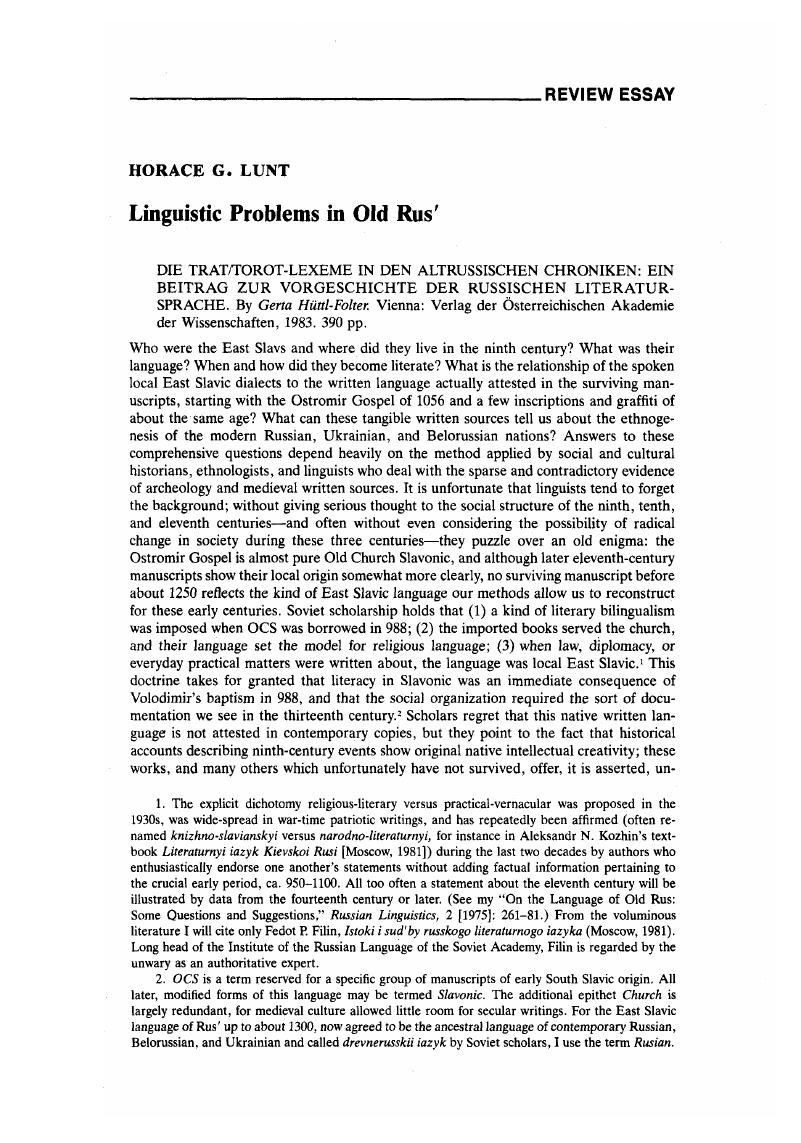Published online by Cambridge University Press: 27 January 2017

1. The explicit dichotomy religious-literary versus practical-vernacular was proposed in the1930s, was wide-spread in war-time patriotic writings, and has repeatedly been affirmed (often renamedknizhno-slavianskyi versus narodno-literaturnyi, for instance in Aleksandr N. Kozhin's textbookLiteraturnyi iazyk Kievskoi Rusi [Moscow, 1981]) during the last two decades by authors whoenthusiastically endorse one another's statements without adding factual information pertaining tothe crucial early period, ca. 950–1100. All too often a statement about the eleventh century will beillustrated by data from the fourteenth century or later. (See my “On the Language of Old Rus:Some Questions and Suggestions,” Russian Linguistics, 2 [1975]: 261–81.) From the voluminousliterature I will cite only Fedot P. Filin, Istoki i sud'by russkogo literaturnogo iazyka (Moscow, 1981).Long head of the Institute of the Russian Language of the Soviet Academy, Filin is regarded by theunwary as an authoritative expert.
2. OCS is a term reserved for a specific group of manuscripts of early South Slavic origin. Alllater, modified forms of this language may be termed Slavonic. The additional epithet Church is largely redundant, for medieval culture allowed little room for secular writings. For the East Slaviclanguage of Rus’ up to about 1300, now agreed to be the ancestral language of contemporary Russian,Belorussian, and Ukrainian and called drevnerusskii iazyk by Soviet scholars, I use the term Rusian.
3. Diglossia is a term coined by Charles A. Ferguson (“Diglossia,” Word, 15 [1959]: 325–40;reprinted many times) for the kind of objective bilingualism that is perceived by most users of thelanguage as the “natural” difference between “good, correct” style required in writing and someformal speech situations, and the “common, dialect, corrupt” everyday language of normal usage.Typically, the “pure” language is a standardized written form based on the speech of a long-goneclassical period or revered body of texts (Czech of the sixteenth century; the Arabic of the Koran);it is something learned from teachers, not from parents and nurses. The most important element ofdiglossia is the perception of society that there is a single language, with “good” and “bad” forms;native speakers often are unaware of the complex nature of their own shifting from one system tothe other. Outsiders, including linguists, find the two systems so obviously different that they regardthem as different languages.
4. See my “Slavs, Common Slavic, and Old Church Slavonic,” Litterae slavicae medii aevi—F. V. Mareś sexagenario oblatae (Munich, 1984).
5. Nikolai S. Trubetzkoy refers to OCS as the “obshcheslavianskii literaturnyi iazyk,” furtherarguing that not only OCS and early Rusian but also the hypothetical dialects we assume for theCzech and Polish areas in the tenth and eleventh centuries are still Late Common Slavic dialects andnot yet separate “Old Polish” and “Old Czech.” Kprobleme russkogo samopoznaniia (Paris, 1927).Nikolai N. Durnovo, after a more detailed scrutiny of the evidence, concurred ( “K voprosu o vremeniraspada obshcheslavianskogo iazyka,” Sbornik práci I. Sjezdu filologu v Praze 1929 [Prague, 1932],vol. 2, pp. 514–26.)Trubetzkoy died in 1938 without returning to these problems. Durnovo vanishedinto prison early in the 1930s. Since their eminently sensible views have been completely ignored bySoviet scholars and neglected by other Slavicists, I have presented them anew, with a broader arrayof data and a different methodological framework, in my “On Common Slavic,” Zbornik zafilologijui lingvistiku, 27 (Novi Sad, 1984).
6. The unsuitability of the diglossia model for Kievan Rus’ was shown in detail in an articlewhich Hiittl-Folter lists in her bibliography, Worth, Dean S., “On ‘Diglossia’ in Medieval Russia, “Die Welt der Slaven, 23 (1978): 371–93.Google Scholar
7. Standard French, Italian, and English illustrate the expansion of dialects (of Paris, Tuscany,and London) perceived by speakers of other dialects as worthy of imitation.
8. Here too she has accepted uncritically assumptions made by other scholars. Compare my “On Writing the History of the Language of Old Rus,” in Halle, M. et al., eds., Semiosis: Semioticsand the History of Culture, Michigan Slavic Contributions, no. 10 (Ann Arbor, Mich., 1984),pp. 303–20.Google Scholar
9. Likhachev, Dmitrii S., Povest’ vremennykh let, 2 vols. (Moscow, 1950).Google Scholar
10. Even very sophisticated Soviet linguists (for instance, Boris A. Uspenskii, Iazykovaia situatsiiaKievskoi Rusi i ee znachenie dlia istorii russkogo literaturnogo iazyka [Moscow, 1983],pp. 3–7) seem to start by assigning meaning to arbitrary labels: because there is a compound epithet “Church Slavonic” , (1) church must be opposed to secular and (2) Slavonic (which = non-Rusian)must be opposed to Rusian. Surely we ought first to analyze the pertinent evidence and only thenassign labels.
11. Lunt, H. G., The Orthography of Eleventh-century Russian Manuscripts (Ann Arbor, Mich., 1950)Google Scholar.